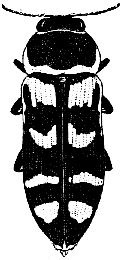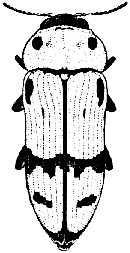 |
Anthaxia manca L. - male
Last abdominal sternite (by L. Schaefer, 1936) |
 |
Anthaxia manca L. - female
Last abdominal sternite (by L. Schaefer, 1936) |
We can speak of sexual dimorphism when we can observe some differences
in the body of males and females of the same species, in addition to obvious
differences in their sexual apparatus. A large part of Vertebrates and
Invertebrates show marked sexual differences, and it is particularly true
for many Insects: Lepidoptera, Coleoptera (Cetonidae, Euchiridae, Cerambycidae,
Lampyridae, Lucanidae, etc) and many others.
Sexual dimorphism is not very evident in Buprestidae, and in many species
it regards just few characteristics, strictly connected to coupling: the
last abdominal segment, widht of tarsal segments, the shape of the first
and second couple of legs, and few others.
 |
Anthaxia manca L. - male
Last abdominal sternite (by L. Schaefer, 1936) |
 |
Anthaxia manca L. - female
Last abdominal sternite (by L. Schaefer, 1936) |
 |
Anthaxia hypomelaena Ill. - male
Hind leg. (by L. Schaefer, 1936) |
 |
Anthaxia hypomelaena Ill. - female
Hind leg. (by L. Schaefer, 1936) |
 |
 |
|
male |
female |
Just some species of few genera show a different colouration beetwen
males and females. The most known is the genus Anthaxia. Many males of
these Buprestidae, especially among Palaearctic species, differ very much
in colour from their females. Here, we can see some examples:
 |
 |
|
male - Madagascar |
female - Madagascar |